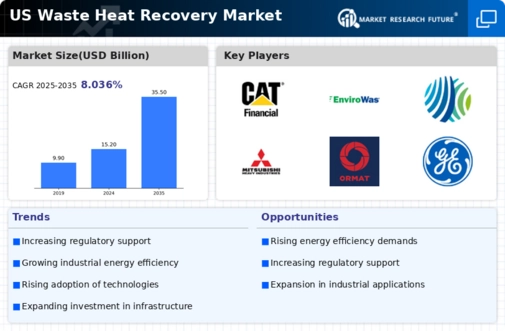Rising Energy Costs
The escalating costs of energy in the US are driving the oil gas-waste-heat-recovery market. As traditional energy sources become more expensive, industries are increasingly seeking alternative solutions to mitigate costs. The oil gas-waste-heat-recovery market offers a viable option by enabling companies to harness waste heat and convert it into usable energy. This not only reduces operational expenses but also enhances energy efficiency. According to recent data, energy costs have risen by approximately 15% over the past five years, prompting industries to invest in waste heat recovery systems. The potential for significant savings is a compelling driver for the oil gas-waste-heat-recovery market, as businesses aim to optimize their energy consumption and reduce reliance on costly energy sources.
Corporate Sustainability Goals
The increasing emphasis on corporate sustainability goals is driving the oil gas-waste-heat-recovery market. Many companies are setting ambitious targets to reduce greenhouse gas emissions and enhance their environmental performance. Waste heat recovery systems align with these goals by providing a means to utilize excess heat generated during industrial processes. As organizations strive to meet sustainability benchmarks, the oil gas-waste-heat-recovery market becomes an attractive option. A survey indicated that over 60% of companies in the manufacturing sector are prioritizing energy efficiency initiatives, further underscoring the market's potential as businesses seek to integrate sustainable practices into their operations.
Government Incentives and Funding
Government incentives and funding programs are playing a crucial role in the growth of the oil gas-waste-heat-recovery market. Various federal and state initiatives are designed to promote energy efficiency and sustainability, providing financial support for companies that invest in waste heat recovery technologies. For instance, the US Department of Energy has allocated substantial funds to support research and development in this sector. These incentives can cover a significant portion of the initial investment, making it more feasible for businesses to adopt waste heat recovery solutions. As a result, the oil gas-waste-heat-recovery market is likely to experience increased adoption rates, driven by the financial backing provided by government programs.
Industrial Demand for Energy Efficiency
The growing demand for energy efficiency in industrial processes is a key driver for the oil gas-waste-heat-recovery market. Industries are under pressure to reduce their carbon footprint and improve operational efficiency, leading to a heightened interest in technologies that can recover waste heat. The oil gas-waste-heat-recovery market presents an opportunity for industries to achieve these goals. Reports indicate that companies implementing waste heat recovery systems can improve their energy efficiency by up to 30%. This substantial improvement not only contributes to sustainability efforts but also enhances competitiveness in a market that increasingly values energy-efficient practices.
Technological Innovations in Heat Recovery
Technological innovations in heat recovery systems are significantly influencing the oil gas-waste-heat-recovery market. Advances in materials and engineering have led to the development of more efficient and cost-effective waste heat recovery technologies. These innovations enable industries to capture and utilize waste heat more effectively, resulting in higher energy recovery rates. For example, new heat exchangers and thermoelectric generators are being integrated into existing systems, enhancing their performance. As these technologies continue to evolve, they are likely to attract more investments in the oil gas-waste-heat-recovery market, as businesses seek to leverage cutting-edge solutions to optimize energy use.




















Leave a Comment